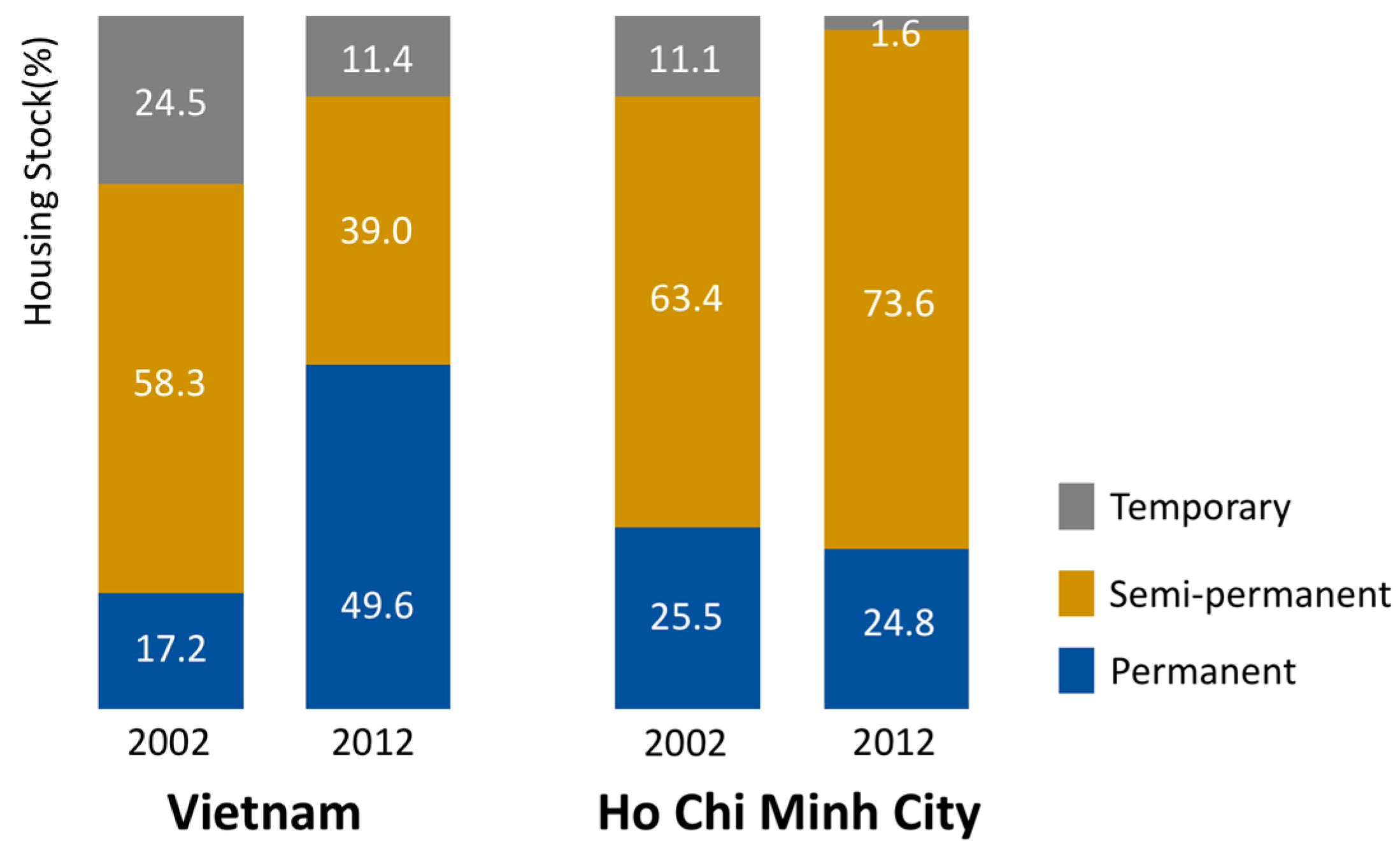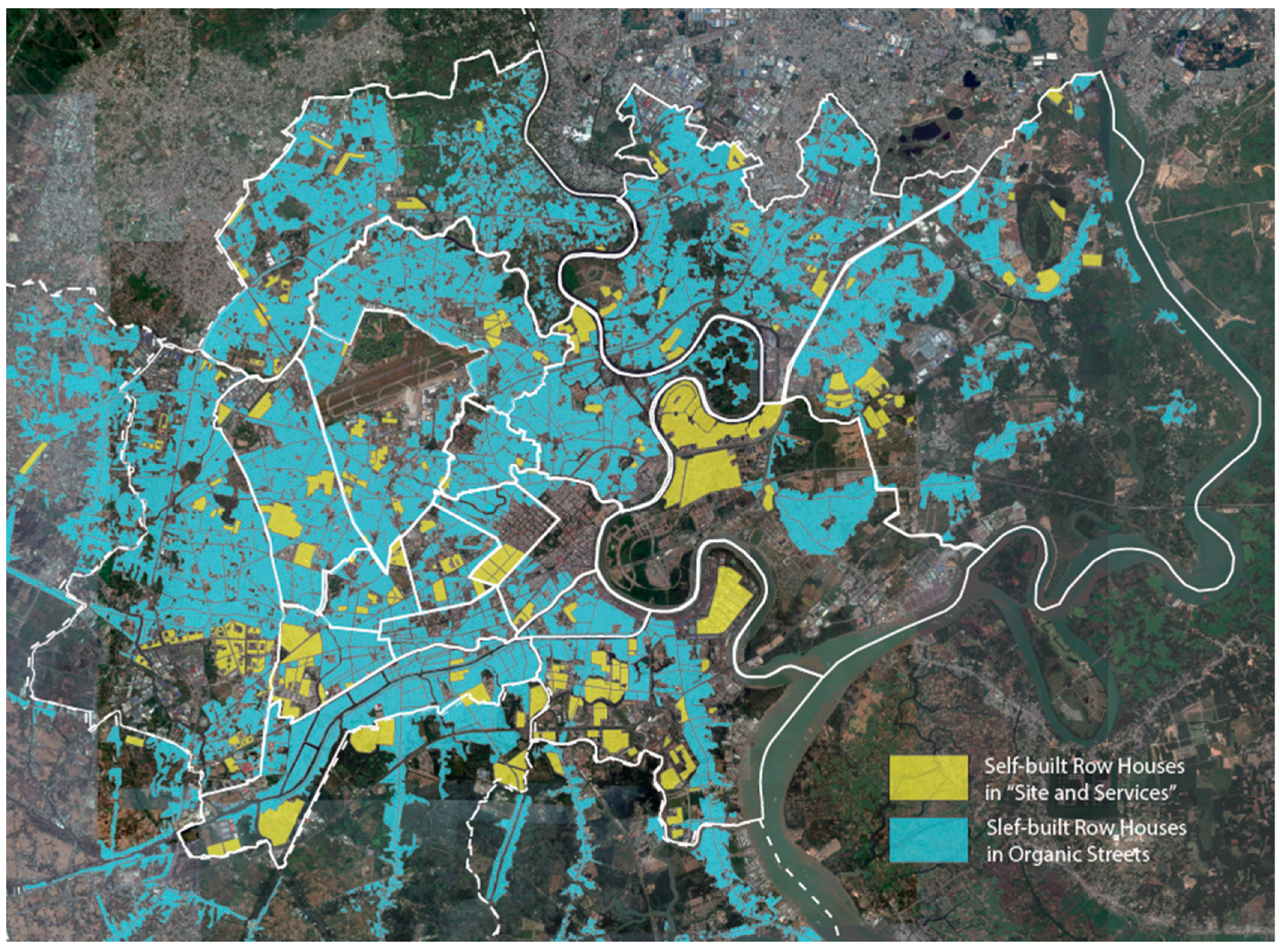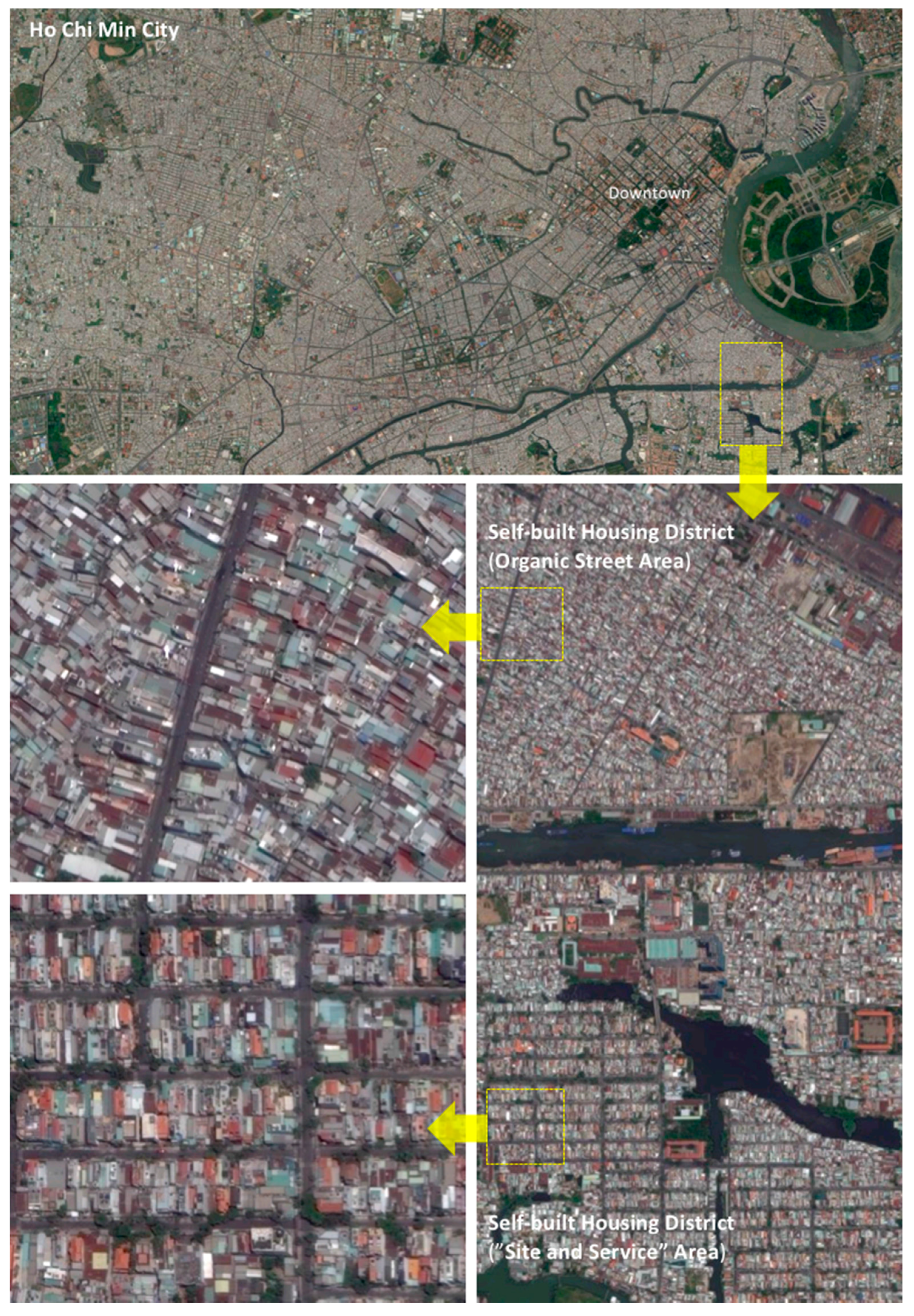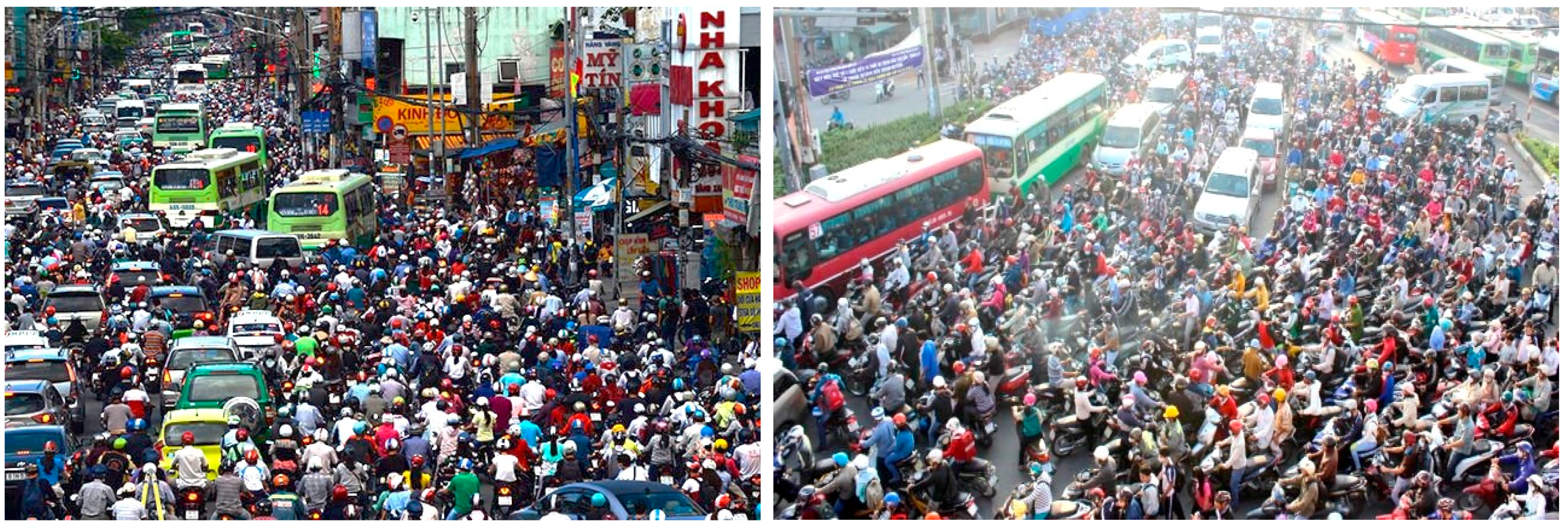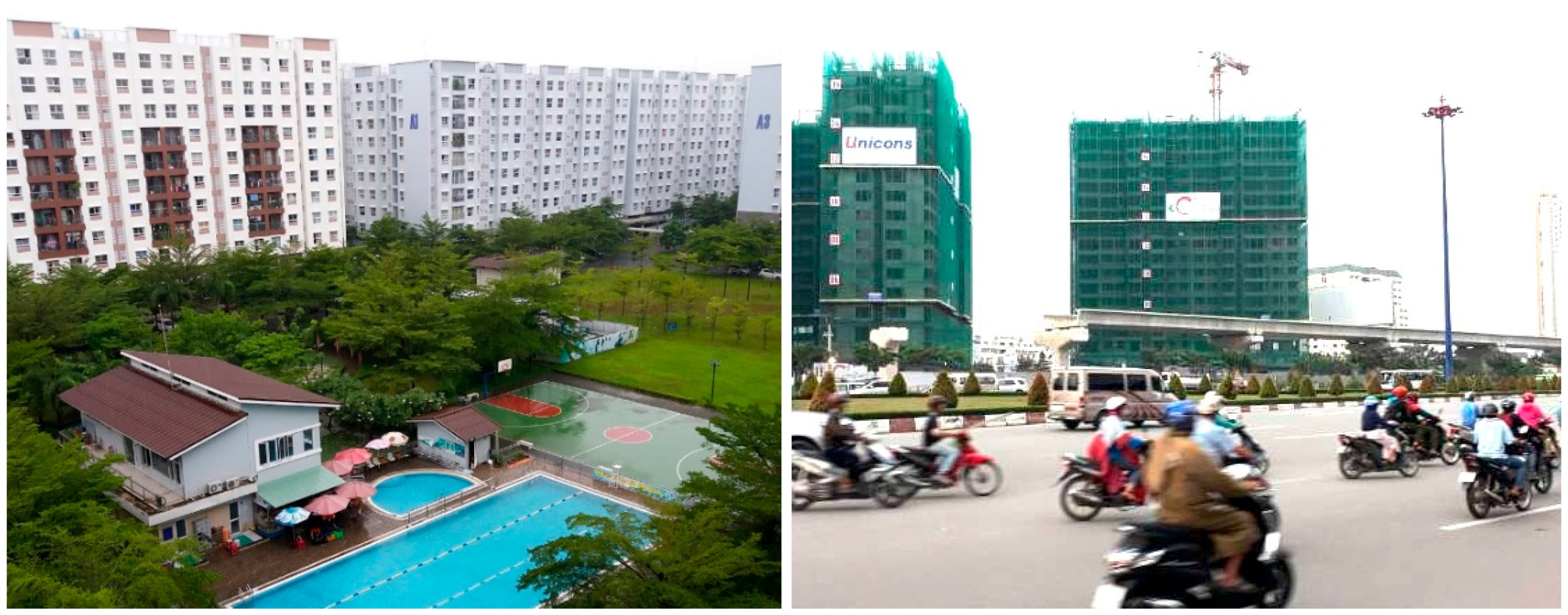1. Introduction
Vietnam’s rate of urbanization has rapidly increased with a great influx of immigrants from rural areas since the initiation of the Doi Moi (Đổi Mới: open door) economic reforms in 1986. The policy goal was to create a socialist-oriented market economy and to accelerate economic transition to industrial manufacturing, leading to employment and economic output [
1]. It resulted in a remarkable increase in foreign direct investment (FDI) into Vietnam and became a significant factor for economic growth in industrial manufacturing development. The phenomenon was especially observed in Ho Chi Minh City (HCMC), Hanoi, and their peri-urban areas with enormous inflows from rural areas [
2]. Nationally, the urban proportion of the population increased from 20.5% in 1990 to 34.7% in 2017 [
3].
Real estate has been a significant sector of FDI in the last decades, ranking second (18%) behind manufacturing and processing industries (58%) in Vietnam (
Figure 1). The foreign investment has focused on luxury housing developments in particular, and has increased remarkably since the revision of the housing laws in 2015 to allow foreigners to own property. Real estate experts believe that the housing market will continue to be a focus of FDI and the dynamics of movement and housing choice in Vietnam will increase [
4].
The concept of housing choice, which is widely used in housing research, is different from housing preference. While the latter refers to the relative attractiveness of housing, the former refers to actual behavior. Even if preference strongly influences housing choice, the buyers consider more than just their preferences. Priemus [
6] highlights the fact that various factors restrain housing choices for potential customers, such as official regulations, market and price, household finance, geographic location, and so forth. More factors can be added that affect the customers’ behavior, such as perception, family, neighborhood, schedule, and lifestyle [
7]. Hooimeijer underlines two motivating powers for the choices. The first is the local real estate market and housing supply, and the second is individual lifestyle change with the progressing life-cycle [
8].
The dynamic of housing preference and choice has been reviewed in several theoretical publications and has led to several models: the Life-cycle, Planned Behavior, and Decision-Making models [
9]. All of them are closely related to social, economic, and cultural aspects of Vietnamese sustainable housing development. From the perspective of the life-cycle model, housing choice and movement rely on family events such as formation (by marriage), expansion (by the birth of children), contraction (by moving out), and dissolution (by divorce or death of a spouse) [
10]. Each phase motivates households to choose a form of housing of suitable size and number of rooms. The phases are also intertwined with education levels, available employment, housing careers, local markets, etc. [
11,
12,
13,
14].
The planned behavior model has been developed from the expectancy-value theory [
12], which is based on behavior being the result of the entirety of the expected values of the characteristics. De Jong and Fawcett [
15] introduced this model for migration decision-making in housing research. The expectancy level is rated via importance evaluation of a set of values, followed by the generation of an attraction score for a specific place and form of housing as a determinant of moving [
16]. In addition, they note that personal and structural backgrounds directly impact migration. The most important intention factors in deciding whether to move or stay are marital status and financial capability [
17].
Another approach to housing choice is viewing the process of decision-making as a series of dynamic problem-solving techniques [
10,
18,
19,
20]. In other words, looking for a new residence is the process of resolving a complicated and ill-structured situation into a relatively satisfying situation. In this context, goal-oriented behavior is highlighted in housing choice rather than just preferences. Customers can derive their goals from economic, social, and environmental issues that repeat and backtrack in their lives. Thus, the housing choice is an optimal behavior to pursue a certain desired quality of life such as happiness, freedom, safety, and security, or, in other words, minimizing the experience of negative emotions [
21].
The goal of this study is to investigate moving and housing choice patterns in HCMC and to try to find implications for future sustainable urbanization and housing development. Housing choice and migration in HCMC seem to be a mixture of the Life-cycle, Planned Behavior, and Decision-Making models, with the last having a particularly strong impact on housing choice in the context of Vietnamese urbanization. The following objectives were set for the research: (1) to investigate housing type choices for the migration; (2) to examine factors influencing movement determination; (3) to understand housing preferences and expected movement patterns; and (4) to find implications for public policies to foster sustainable housing development in Vietnam.
3. Research Methods
According to Vietnam’s regional and urban administration hierarchy system, Vietnam’s cities are categorized into 6 classes based on the level of economic development, physical development, population and its density, and infrastructure provision. HCMC was classified as one of the two national “special” cities, a top ranking, due to its significant economic and political contributions to the country [
33]. HCMC has 9.2% of Vietnam’s total population and is responsible for 20.8% of its GDP (2016). In this context, HCMC has experienced the highest levels of urbanization and industrialization, population growth, and housing development. This trend is also found in other cities. As most cities want to climb the city class ladder to receive better recognition and financial support from the central government, they are pursuing growth patterns similar to those of HCMC. As a result, the city is considered a significant reference as a development model in Vietnam.
Therefore, this research decided to empirically investigate and analyze housing choice and movement patterns in HCMC using a citizen questionnaire survey (
Supplementary Materials). The city officially consists of 24 districts divided into three groups: 13 urban districts, 6 semi-urban districts, and 5 rural districts [
3]. As the rural districts with low population density were relatively unaffected by HCMC’s urbanization, they were excluded from this survey. The other districts, however, experienced remarkable changes in their residential environment [
33]. The questionnaire survey therefore targeted the 13 urban districts (1, 3, 4, 5, 6, 8, 10, 11, Phu Nhuan, Binh Thanh, Go Vap, Tan Binh, and Tanh Phu) and six semi-urban districts (2, 7, 9, 12, Binh Tan, and Thu Duc) (
Figure 5).
To increase accuracy and reflect local realities, a preliminary survey was carried during 11–20 June 2016. We selected two urban districts (District 1 and Phu Nhuan) and two semi-urban districts (District 7 and Go Vap) in terms of diversity of density, income, housing typology, and history. District 1 is a downtown and business district mainly crowded with high-end apartments. Phu Nhuan is a low-rise residential area for the upper-middle-income class while Go Vap is a self-built district for the lower-middle-income class. District 7 includes both old and new towns (Phu My Hung) with a good mixture of various housing types. We interviewed about 20 households (row houses and apartments) from the four districts to get a specific understanding of local citizens’ housing issues and preferences. Various reasons for moving as well as issues relating to the residential environment were identified by the questionnaire. For instance, Mrs. Nugyen (55 years old), a row-house household, noted that “My family lived in the countryside of the Mekong Delta region and moved to Ho Chi Minh to set up a small business twenty years ago. I lived in temporary housing when we settled down in District 12, a suburban district, and moved to a row house to work and live. My family operated a rice noodle shop on the ground floor and lived on the second floor. The row house was optimal for combining business with living for our family. I will choose a row house again for my business even if I move again.” Mr. Hien (45 years old), a government official, had a different story. “I have been working as a civic official for 15 years. I had lived in social housing in a middle-rise apartment. Then I moved to my present high-rise apartment five years ago. Commuting to work was a very important factor when choosing this apartment. I commuted by bicycle for a decade but now do so by motorcycle. The motorcycle trip of over an hour is extremely tiring due to serious air pollution and noise on the road. There is very little public transportation and the number of cars and motorcycles has increased too much every year. I am satisfied with the current apartment because of proximity to my office, a spacious parking lot with a security guard, and public facilities like a community park and swimming pool.” The questionnaire was updated based on this feedback from the preliminary survey.
The questionnaire mainly consists of four parts. The first is about the interviewee’s background and general understanding of urban issues in HCMC. The second indicates housing and neighborhood conditions in their former housing. The third is about current housing and neighborhood. In the last part, respondents were asked about housing type preferences in the future if they could afford any housing type (
Table 2). By investigating past, present, and future housing in the survey, we expected to find movement patterns and the reasons for them.
Housing types in this survey were categorized into squatter, row house, villa, and apartment. The official Census of Vietnam categorizes the typology into permanent, semi-permanent, and temporary housing based on housing quality and materials [
26]. However, this imposes limitations in understanding diverse urban housing stocks. The UN Habitat categorizes Vietnamese urban housing as shop house, apartment, villa, alley house, and precarious squatter housing in accordance with a functional classification [
3]. However, the shop house and alley house are structurally similar in terms of narrow and long plot size, nearly 100% plot coverage, and an average of three or four floors. Both properties also typically belong to the single-family ownership category. The only main difference is whether the ground floor is used for commercial or residential purposes. World Bank research gives five categories of housing typology: temporary shelters, old townhouse, new townhouse, apartment, and villa [
33]. The old and new townhouses can be recognized as being the same as the shop house and alley house of the UN Habitat’s categories in terms of architectural form. Thus, this study combined those types into the row house (also commonly called “nhà ống” in Vietnamese or “tube house” in English) category. Therefore, in this survey, residential housing was classified into four types: squatter, row house, villa, and apartment.
The questionnaire survey was performed from 1 September to 30 November 2016 in HCMC. The interviewees were selected in popular public places such as streets, squares, parks, and commercial locations in the target 19 districts (13 urban and 6 semi-urban districts). Then personal interviews were conducted. A total of 200 responses were collected evenly across the districts but, following a review of data quality and missing response elements, 194 samples were finally selected.
Table 3 shows the detailed information about the survey data collection.
6. Discussion and Conclusions
Housing choice and movement issues in HCMC have become intertwined with HCMC’s rapid urbanization and housing market growth. Since the economic reforms, social and economic changes have led to huge in-migration levels and exacerbated housing shortages, leading to the system for the supply of housing being taken over by the private sector. The government has revised the land use laws, not only for the purpose of privatizing residential land but also to encourage self-built housing through investment by individual households. This development pattern has predominated for the last few decades in HCMC. The self-built row houses have largely covered the city, with organic district expansion and urban densification. This empirical study shows the popularity of the row houses due to the environmental adaptability and spatial flexibility of the mixed-use building, which shows its cultural and social sustainability in Vietnam’s innate housing context. However, road conditions and commuting environments in the predominantly self-built districts of HCMC were major drawbacks due to narrow inner roads and limited accessibility by cars and public transportation. On the other hand, FDI inflows have produced numerous launches of new apartment projects with a surge in the upper middle-income class. This housing type attracts residents because of great accessibility to main roads, spacious parking spaces, and decent housing quality. It is also considered for economically sustainable housing supply policies aimed at delivering numerous affordable housing units accessible to the lower middle-income class in the dense and compact environment of HCMC.
This housing study has implications for public policies aiming at sustainable housing development in Vietnam. As the new 2015 Housing Law provides the framework to support affordable housing segments (with a focus on the housing shortage and the necessity of creating affordable decent housing for the lower-middle class), support for self-built housing, and encouragement of private sector involvement. The government can consolidate their efforts in the affordable housing sector in the following ways.
First, the government should establish national affordable housing initiatives to effectively manage and control incremental informal self-built housing development. Although the row house is regarded as a sustainable housing model for Vietnam from an environmental and socio-economic point of view [
34,
35,
36,
50], the predominant informal self-building trend has had a negative impact on the urban environment with unsustainable densification patterns. Therefore, this development should be well managed and regulated, given that this type of house is a popular choice and in high demand by many Vietnamese. The initiatives can strengthen regulation of row house development and precisely target areas and groups of lower-income households for special assistance who are unable to undertake self-provided solutions. The initiatives can also develop viable strategies for basic infrastructure provision to secure public health and transportation accessibility. In addition, they should enhance accessibility to microfinance and technical assistance for poor households from a formal construction start to incremental self-built housing improvement for their homes. Then, the self-built housing environment can become sustainable in well-serviced and connected neighborhoods.
Second, the government should strategically expand “site and services” projects to meet the increasing demand for row houses by the use of public–private partnerships (PPPs). These develop new serviced lands in suitable locations in cities and provide them in sub-divided plots at lower market rates for affordable housing. Based on the delivery of infrastructure and roads, the landowners can create self-built housing through their own investment with the government’s legal support. This means that the uncontrolled informal formation of self-built districts and its negative externalities such as public health and traffic issues due to lack of infrastructure and inner roads can be avoided. In addition, it can create a framework of public participation since the “site and services” approach can also be used for various purposes such as neighborhood redevelopment with resettlement, land sharing, and in-situ expansion. In this case, the government and stakeholders can support inclusive planning enabling open discussion and participatory neighborhood design with the people who will finally settle in the area. Furthermore, “site and services” projects can be combined with affordable apartment development within PPPs, thereby making the national housing supply more economically and socially sustainable. The apartment is the housing type on which private developers have mostly focused for the upper-middle class for the last several decades in Vietnam, in response to increasing popularity and it being an efficient investment model where land is limited. The government should strengthen the PPPs for affordable apartment development as well. More incentives will be required, such as development right incentives, Land Use Right Fee (LURF) exemptions, and preferential mortgage programs [
22], to motivate the private developers in the affordable apartment sector, while diminishing vulnerability to investment and the variability of the real estate market.
Last, Vietnamese housing development should be integrated with urban development strategies, particularly land use planning, and accompanied by major infrastructure and public transportation development. As this study shows a meaningful association between housing choice and commuting environments, the government should ensure that appropriate land for formal and affordable housing developments is allocated to secure connectivity to basic infrastructure and accessibility to public transportation and urban roads. In the case of in-situ resettlement housing development, which avoids evicting low-income residents to the outskirts, the development should also be prioritized to combine with road-widening plans and transport development. This will minimize negative externalities, such as traffic congestion, pollution, and social segregation. Furthermore, the networked-compact city along with the multi-nuclear model would be necessary to prevent urban sprawl in the sustainable housing development process. It will provide better directions for the style and location of new housing developments as well as site upgrading. These kinds of housing development approaches will help make urban growth in Vietnam more socially, economically, and environmentally sustainable. Therefore, understanding and approaching housing development as part of an inclusive framework is vital for sustainable growth in Vietnam.

